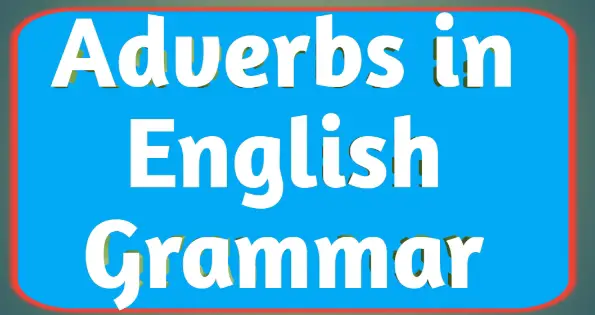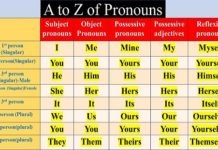What is an adverb
He is a very good human.
I want to go home.
He behaved rudely with me.
Focus on the first sentence. The word “very” modified the adjective “good”. When you ask that he is good but what kind of good? or what is the level. The answer is very good and this “very” is an adverb.
Now let’s see the second sentence. I want to go home- where? the answer is to home. By asking where you are getting an answer and this answer is an adverb.
Next is how he behaved? rudely right? This is also an adverb.
An adverb is a word which modifies a verb.Basically an adverb tells us about the condition of a verb, an adjective or sometime another adverb. By asking “how”,”where”,”when”,”why” you can find an adverb in a sentence.
For example:
The bird is flying swiftly.
If you ask how the bird is flying you will find the adverb swiftly.
Here are some examples also,
He is very handsome.
She talks good.
I will visit there lately.
Luckily,we are at home.
Finally, our work is done.
So,it is very easy to find out an adverb.
Types of adverbs
There are 3 types of adverbs in english grammar.
Simple Adverb
Interrogative Adverb
Relative Adverb
a. Simple Adverb
An adverb which directly modify a verb or an adjective or a sentence.
For example:
We went early.
She can write fast.
She will come late.
This ‘simple adverb’ is 8 kinds of. They are,
1.Adverbs of time
This adverb indicates the time. By asking a question with “when” you can find this adverb.
For example:
She will come late.
I came back soon.
He will come here today.
We rise early in the morning.
2.Adverbs of place
This adverb shows us where is the verb . That’s mean if you ask a question with “where” you will find this adverb easily.
For example:
I was there.
The ship went down.
Come in.
She ran away .
3.Adverbs of manner
If you ask a question that how the verb is or how the verb is doing you will find an adverb in the sentence.
For example:
He walks slowly.
How he is walking? The answer is slowly. This slowly is an adverb which is adverb of manner . Here are more examples,
They worked hard.
This brush works well.
4.Adverbs of frequency
By this adverb we can find out that how many times the verb has completed it’s work.
For example:
He often comes here.
I have met him once.
He sometimes comes to the collage.
5.Adverbs of quantity
This adverb shows us the quantity of a verb.
For example:
He is very strong.
He is too weak.
I know a little about this topic.
6.Adverbs of affirmation and negation
This kind of adverbs express the “yes” or “no” condition.
For example:
Yes, you are right.
You are probably wrong.
7.Adverbs of cause and effect
This adverb shows us the after effect of a verb’s doing. It indicates the reason and result.
For example:
Hence, he was allowed to the job.
8.Adverbs of order
It shows the order of an verb.
For example:
Firstly, we have to move from here.
Secondly, we will remove these bags from there too.
Finally, we have reached here.
b.Interrogative Adverb
By those adverbs we can ask question are Interrogative adverbs.
For example:
How about you?
Why are you tensed ?
What are you doing?
C. Conjunctive Adverb:
If an adverb is modifying a verb and also connection two clauses is conjunctive adverb.
For example:
I know where she lives.
Formation of Adverbs
Basically by adding “ly” with an adjective it becomes an adverb.
For example:
He talks loudly.
She laughs cutely.
Luckily, I didn’t get any pain.
This place is noisy.
Here Loud is an adjective but by adding “ly” with this, it became an adverb.
If an adjective ends with the letter Y and if there is a consonant before this then we’ll have to use i instead of Y and will have to add ly to make an adverb.
For example:
Lucky – Luckily
Happy- Happily
Lazy- Lazily
- Use ally at the end of an adjective to make an adverb which ends with ic .
For example:
Basic- Basically 4.If an adjective ends with LL then use Y in the place of LL to make it an adverb.
For example:
Full- Fully There are some adjectives who look like adverbs but they are not.
For example: likely, friendly etc.
Position of Adverbs
There are 3 positions of adverbs. They are,
Mid- Position
End- Position
Initial- Position
1.Mid-position:
There are some adverbs which stand at the middle of a sentence.Adverb of frequency basically stands at the middle.
For example:
He always speaks the truth.
The bus will surely be late.
2.End-position:
Adverb of time, adverb of manner and adverb of place stand at the middle of an sentence.
Let’s walk slowly.
He wakes up lately.
Come here.
3.Initial- Position:
There are some adverbs which mainly stands at the before of a sentence.
For example:
Actually, they are not right.
Surely, you will get your money.
adverbs can stand easily in all positions.
How to Practice
To practice what you’ve learned about adverb from here, try to find out adverbs from everywhere.Read books or newspapers and read lines and try to find out adverbs and also must try to identify all kinds of adverbs. By doing this you will easily find those and you will learn quickly that when we can use adverb and how it modify .
Start practicing from here. Here are some lines. Find out the adverbs.
1.She is very cute .
2.He went away yesterday.
3.I like it very much .
- You can run fast.
5.The man is running very fast.
I hope you will find all adverbs.
Use advebs when you want to say the condition of a verb. Understanding and finding an adverb is very easy. Practice makes a man perfect so do more practice.

















